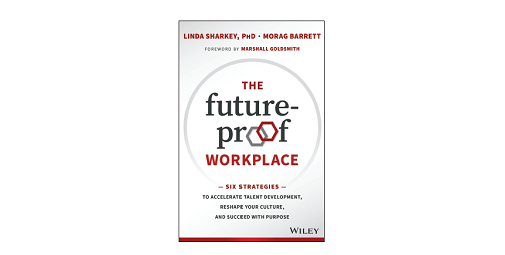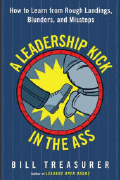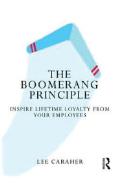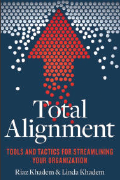TD Magazine Article
A Guide to Getting Ready for 21st-Century Workers
A review of T he Future-Proof Workplace: Six Strategies to Accelerate Talent Development, Reshape Your Culture, and Succeed with Purpose by Linda Sharkey and Morag Barrett
Sat Jul 01 2017

The Future-Proof Workplace: Six Strategies to Accelerate Talent Development, Reshape Your Culture, and Succeed with Purpose
By Linda Sharkey and Morag Barrett
Wiley, 240 pp., $28
The Future-Proof Workplace targets HR professionals and company leaders across industries to explain how they or their workplaces might be underprepared for the future. The book explores eight areas that leaders should investigate to ensure they’re equipped for the influx of 21st-century workers headed their way: leadership, culture, purpose, relationships, diversity, technology, learning, and workspace.
Each chapter focuses on examples of how companies innovate to address the future needs of employees. The structure alternates between discussions about how readers can personally future-proof their careers, and methods they should consider when doing the same for their companies.
This book is ideal for leaders who feel they don’t have a firm grasp on the future’s trends. It targets people who worked primarily in the 20th-century workplace, contrasting what those individuals want from their employers with what the next generation expects.
Sharkey and Barrett begin with a high-level acknowledgment of changes in the workplace: As a leader, you do not have the luxury of ignoring these changes or your company will sink. The new workforce is too diverse, global, and flexible to tolerate companies and leaders who can’t keep up. The authors then delve into the eight areas that leaders should focus on to withstand the “waves of change.”
Some of these themes are more obvious than others. The chapters “Technology” and “Purpose” offer little fresh content; this certainly isn’t the first time I have read that keeping up with technology is essential or that Millennials prefer companies with a purpose.
Other chapters, such as “Learning” and “Diversity,” contain more novel ideas.
In “Learning,” the authors posit that the concept of college is antiquated—it simply takes too long. Today’s workforce needs skills at the pace of technological innovation, which is much faster than the typical four-year degree cycle. They predict that future leaders will look to nano-degree programs and other rapid, nontraditional programs to train their staff.
Meanwhile, “Diversity” focuses on the neuroscience behind exclusion. The chapter manages to call most leaders innate discriminators without blaming them, yet encourages the end of these conditioned thinking patterns. It is a fascinating take on diversity in the workplace.
Overall, The Future-Proof Workplace is a good read for any leader who feels left behind in the new century, especially those interested in how the ways people acquire skills or include each other in the workplace will change. The main weakness of the book is that while the authors describe methods that companies have used to tackle different issues, they don’t provide any manageable steps that companies without monster budgets can take. If you’re a middle manager (versus a CEO) or your company has finite resources, I worry that takeaways will be in short supply. However, the authors do bring great experience on how individuals and forward-thinking companies are future-proofing now.
A Leadership Kick in the Ass: How to Learn from Rough Landings, Blunders, and Missteps

Bill Treasurer
Berrett-Koehler, 200 pp., $17.95
"I am no leadership scholar," declares Treasurer in his book's introduction. "I am a leadership plumber," someone who studies leadership by working directly with people to "remove whatever hairballs may be mucking up their leadership pipes"—a messy process at best. In his studies, Treasurer has learned that every leader deals with mistakes, embarrassments, and failures. What separates good leaders, he's found, is the ability to feel humbled by those hardships, and then learn from them. This book will teach readers how to harness the most difficult moments of being a leader, showing how to minimize the damage those events cause and maximize the wisdom they proffer.
The Boomerang Principle: Inspire Lifetime Loyalty From Your Employees

Lee Caraher
Routledge, 194 pp., $24.95
The Boomerang Principle takes a poignant look at why the relationships between organizations and their employees have changed in recent years, especially after 2008's Great Recession. Indeed, the traditional concept of employee loyalty has died: People don't expect one company to take care of them for their entire careers anymore. However, many employers still hold grudges against former workers for leaving. Caraher argues that those grudges hurt companies, and her book advocates for understanding that employees will leave, then supporting them when they do. That builds an alumni base that is eager to do business with you or resume working for you if the opportunity arises.
Total Alignment: Tools and Tactics for Streamlining Your Organization

Riaz Khadem and Linda Khadem
Entrepreneur Press, 224 pp., $21.95
In Total Alignment, the authors confront a perennial challenge: Companies often struggle to create action that supports their strategies, with employees and departments either passively resisting change or openly fighting it. The book introduces a framework to answer questions about how to combat that issue, showing readers how to align an organization's practices with markets, and its own vision, values, and strategies. The best part? As the authors write, "the solutions we present are more than theoretical concepts. They include unique processes, practical methodologies, and easy-to-use tools." Those words hold true, making this an excellent read for anyone who wants to understand the how of organizational alignment.
What's on Rick Lozano's Bookshelf?
Usable Usability: Simple Steps for Making Stuff Better by Eric Reiss. I'm halfway through this right now. I'm always creating something—learning experiences, presentations, webpages, music—and the principles I'm reading can apply to all of them. I need all the help I can get.
Brain Rules: 12 Principles for Surviving and Thriving at Work, Home, and School by John Medina. This book presents simple ideas based on brain research that can easily apply to just about anything. I find myself revisiting it whenever I'm creating new programs or learning events to make sure I'm truly driving learning and behavioral change. And it reveals interesting facts along the way—did you know studying music makes children more empathetic?
Lamb: The Gospel According to Biff, Christ's Childhood Pal by Christopher Moore. When I need a break from work stuff, anything by Christopher Moore is a hilarious way to relax while floating in a pool. If you can get past the irreverence in this book (a story of Jesus's missing years as told by his pal, Biff), it is truly a great story that frequently finds me laughing out loud.
